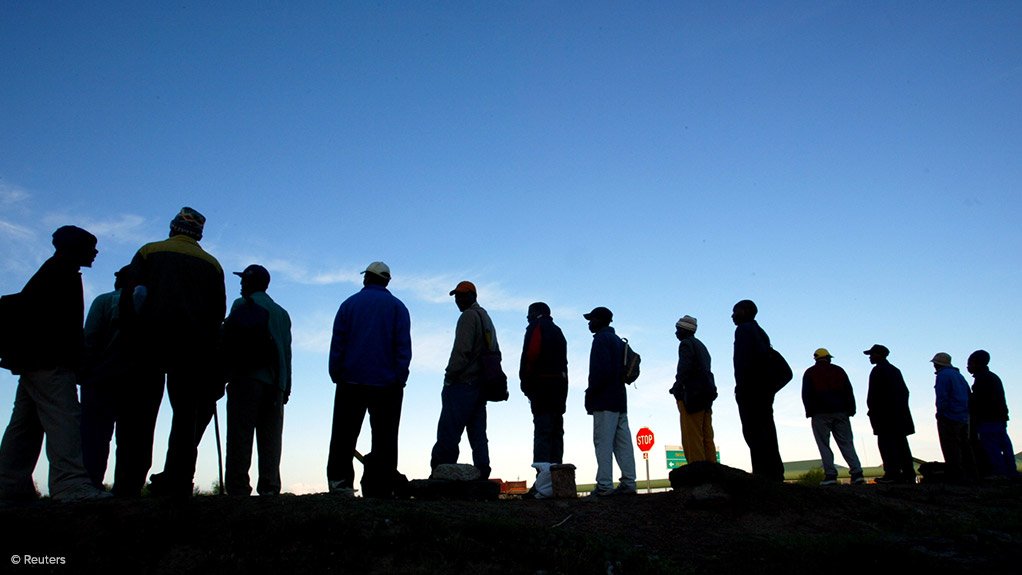The results of the Quarterly Labour Force Survey for the fourth quarter of 2016 released by Statistics South Africa on Tuesday indicate that employment grew by 235 000 and the number of job seekers declined by 92 000, resulting in a slight decline in the official unemployment rate by 0.6 of percentage point to 26.5%.
However, this is still 2.0 percentage points higher compared to the same period last year.
The working age population grew by 155 000 or 0.4% and the labour force grew by 143 000 persons in the fourth quarter of 2016 compared to the previous quarter. The section of the population which is not economically active rose by 12 000, of which 1 000 were discouraged work-seekers.
The growth in employment was mainly driven by the Services industry which grew by 73 000, followed by Transport and Manufacturing which grew by 46 000 and 44 000 respectively.
All other industries reported quarter-to-quarter (q/q) employment growth except Mining and Construction, which declined by 17 000 and 9 000 respectively.
Employment rose in all sectors, with formal sector employment rising by 127 000 while informal sector employment increased by 53 000. Employment in Agriculture went up by 38 000 and private household Agriculture employment by 17 000.
The year-on-year employment gains of 51 000 largely consisted of Transport, Agriculture and Finance and other business services industries which grew by 61 000, 59 000 and 56 000 jobs respectively.
Employment declines were reflected in four of the ten industries namely Mining (62 000), Trade (58 000) Community and social services (53 000) and Manufacturing (11 000).
Year-on-year changes show employment gains in the Finance and other business services (97 000), Transport (48 000) and Utilities (6 000) industries, while Construction remained unchanged. Between the fourth quarter of 2015 and the fourth quarter of 2016, job losses in the formal sector were observed in four industries, with the largest declines recorded in the Mining (65 000), Community and social services (51 000) and Trade (44 000) industries.
The largest employment gains in the informal sector were recorded in Manufacturing (29 000), Community and social services (25 000) and Trade (21 000) in the fourth quarter of 2016 compared to the third quarter of the same year. This sector recorded quarterly employment losses in the Finance and other business services (27 000) and Transport (1 000) industries.
Compared to fourth quarter of 2015, employment levels in the informal sector declined in Finance and other business services (42 000), Trade (14 000) and Community and social services (2 000). The largest annual employment gains were observed in the Construction (44 000), Transport (13 000) and Manufacturing (6 000) industries during the same period.
Compared to the fourth quarter of 2015, employment lifted by 51 000 or 0.3% while unemployment grew by 588 000 or 11.3%.
This led to an increase in the unemployment rate by 2.0 percentage points to 26.5%. Despite the quarterly growth, the inactive population in the fourth quarter declined (down by 6 000) compared to the fourth quarter of 2015. This drop was mainly observed in the other (not economically active) population.
The unemployment rate declined in four of the nine provinces, with North West registering the biggest decline of 4.0 percentage points. Other provinces which reported a decline in unemployment rates included Limpopo (2.6 percentage points), Western Cape (1.2 percentage points) and Gauteng (0.5 of a percentage point).
The expanded unemployment - which includes those who wanted to work but did not look for work - decreased by 116 000, resulting in a decline of 0.7 of a percentage point in the expanded unemployment rate to 35.6%. However, this still amounts to 8.9 million persons who were unemployed but wanted to work.
The youth (aged 15 to 34) remain vulnerable in the labour market with an unemployment rate of 37.1% - 10.6 percentage points above the national average. However, the youth unemployment rate registered a decline of 1.1 percentage points q/q.
Education plays an important role in labour market outcomes, with those with who do not have matric contributing 59% of the unemployed with an unemployment rate of 31.2%. On the other hand, the unemployment rate among graduates was 7.0% in the fourth quarter of 2016.
EMAIL THIS ARTICLE SAVE THIS ARTICLE
To subscribe email subscriptions@creamermedia.co.za or click here
To advertise email advertising@creamermedia.co.za or click here











